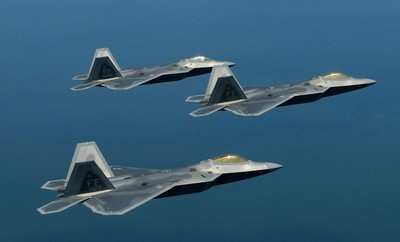Sun, Nov 23, 2014
Heat Generated By Electronic Systems A Growing Challenge
Managing heat that is generated by electronic subsystems in next-generation aircraft is a vexing challenge for aerospace system designers. In the interest of meeting this challenge, the Air Force recently provided follow-on funding for a Small Business Innovation Research (SBIR) effort that is identifying improved methods for heat conduction and rejection from system electronics for advanced fighter aircraft.

To accomplish these goals, the Air Force SBIR/Small Business Technology Transfer (STTR) program office is providing nearly $1.5 million to further mature this technology for the Air Force Research Laboratory (AFRL).
The objective of the SBIR Phase II follow-on contract with ADA Technologies, Inc., located in Littleton, Colorado, is to enhance the technology and manufacturing readiness for nano-enhanced thermal interface material grease and to integrate it with power system modules that are currently used on advanced fighter aircraft.
According to ADA Technologies' principal investigator, Dr. Sayangdev Naha, ADA's thermal grease offers "ultra-low thermal impedance at a fraction of the filler concentration compared to state-of-the-art, which enables this grease to sustain desired performance through severe thermal cycling conditions."
"With further testing, the thermal interface material grease is expected to provide a 10 degrees Celsius or better reduction in junction temperatures," said Dr. James Scofield, the AFRL researcher managing the project. "This reduction in temperature is expected to provide a direct increase in fuel cooling loop temperatures, improved end-of-mission thermal capability during ground idling, and improved reliability and cost savings."

In addition, this program leverages more than $3.95 million in additional AFRL mission funds and the independent research and development funds from the participating companies. These funds will help ensure the Phase II project graduates into a Phase III program that successfully transitions the technologies into military or private sectors.
The Air Force SBIR and STTR programs are mission-oriented programs that integrate the needs and requirements of the Air Force through research and development topics that have military and commercial potential. The SBIR program was established by Congress in 1982 to fund research and development through small businesses of 500 or fewer employees. The STTR program was established in 1992 to fund cooperative research and development projects with small businesses and nonprofit U.S. research institutions, such as universities.
Since 2006, the Commercialization Readiness Program has directly linked Air Force centers to Air Force Research Laboratory technical points of contact to identify and evaluate Air Force needs and innovative solutions. Its primary objective is to accelerate the transition of SBIR/STTR-developed technologies into real-world military and commercial applications.
The Air Force SBIR and STTR programs provide more than $300 million in funding for research and development activities by small businesses annually. With this budget, the Air Force funds research from the early stages of concept development until it transitions to military or commercial use.
(Images from file)
More News
Runway Lead-in Light System Runway Lead-in Light System Consists of one or more series of flashing lights installed at or near ground level that provides positive visual guidance a>[...]
Aero Linx: Aviation Without Borders Aviation Without Borders uses its aviation expertise, contacts and partnerships to enable support for children and their families – at hom>[...]
Dave Juwel's Aviation Marketing Stories ITBOA BNITBOB ... what does that mean? It's not gibberish, it's a lengthy acronym for "In The Business Of Aviation ... But Not In The Busine>[...]
From 2010 (YouTube Version): Yeah.... This IS A Really Cool Job When ANN's Nathan Cremisino took over the lead of our Aero-TV teams, he knew he was in for some extra work and a lot>[...]
Also: Junkers A50 Heritage, Montaer Grows, Dynon-Advance Flight Systems, Vans' Latest Officially, the Carbon Cub UL and Rotax 916 iS is now in its 'market survey development phase'>[...]
 ANN's Daily Aero-Term (04.24.24): Runway Lead-in Light System
ANN's Daily Aero-Term (04.24.24): Runway Lead-in Light System ANN's Daily Aero-Linx (04.24.24)
ANN's Daily Aero-Linx (04.24.24) Aero-FAQ: Dave Juwel's Aviation Marketing Stories -- ITBOA BNITBOB
Aero-FAQ: Dave Juwel's Aviation Marketing Stories -- ITBOA BNITBOB Classic Aero-TV: Best Seat in The House -- 'Inside' The AeroShell Aerobatic Team
Classic Aero-TV: Best Seat in The House -- 'Inside' The AeroShell Aerobatic Team Airborne Affordable Flyers 04.18.24: CarbonCub UL, Fisher, Affordable Flyer Expo
Airborne Affordable Flyers 04.18.24: CarbonCub UL, Fisher, Affordable Flyer Expo




